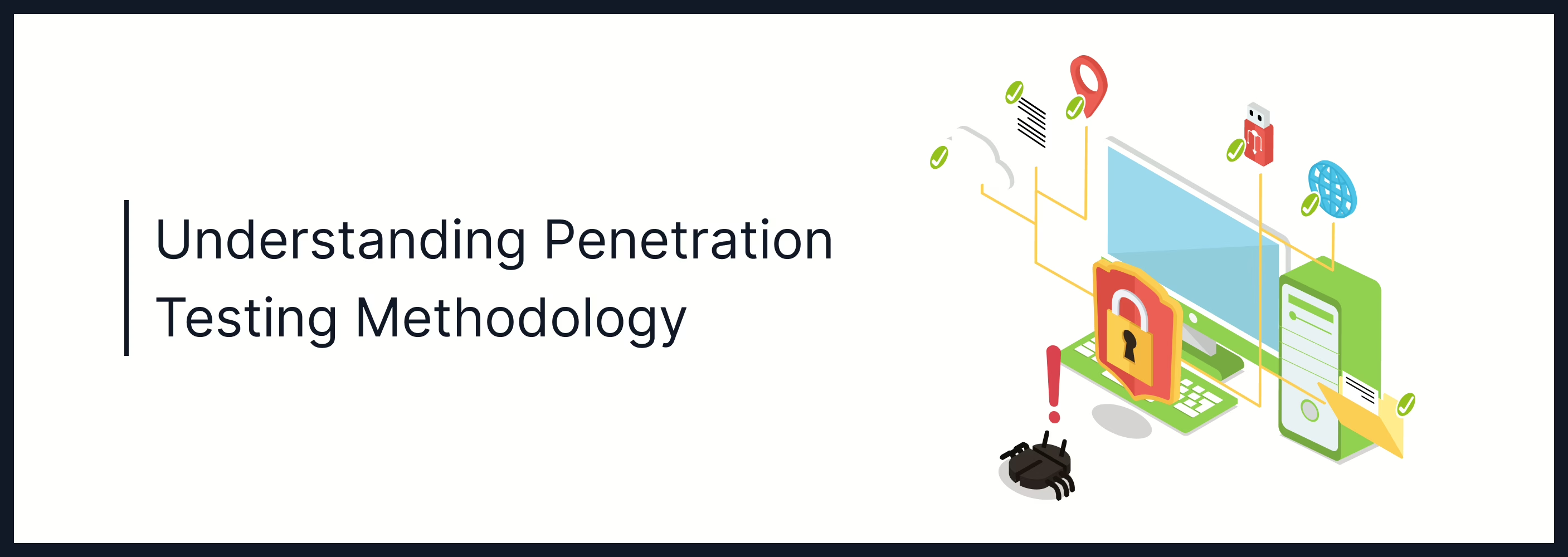
Oct 15, 2024 Information hub
Understanding Penetration Testing Methodology: A Guide to Strengthening Cybersecurity
In today’s digital age, cybersecurity is no longer a luxury but a necessity. With the increasing number of cyberattacks, data breaches, and vulnerabilities, organizations are under constant threat. One of the most effective ways to safeguard against these threats is through penetration testing. But what exactly is penetration testing, and why is it so crucial? Penetration testing, often referred to as pen testing, is a simulated cyberattack against a system, network, or application to identify vulnerabilities that could be exploited by malicious actors. The goal is to uncover weaknesses before attackers do, allowing organizations to patch them and strengthen their defenses. The process of conducting a penetration test follows a structured approach known as the penetration testing methodology.
In this blog post, we will delve deep into the penetration testing methodology, exploring its significance, the steps involved, and its relevance in today’s cybersecurity landscape. We will also discuss current trends, challenges, and future developments in the field, providing practical examples and actionable insights.
The Relevance of Penetration Testing Today
The Growing Threat Landscape
The digital transformation of businesses has brought about numerous benefits, but it has also expanded the attack surface for cybercriminals. According to a report by Cybersecurity Ventures, cybercrime is expected to cost the world $10.5 trillion annually by 2025. This staggering figure highlights the urgent need for robust cybersecurity measures, with penetration testing being a critical component.
Regulatory Compliance
Many industries are subject to strict regulations that mandate regular security assessments. For instance, the Payment Card Industry Data Security Standard (PCI DSS) requires organizations that handle credit card information to conduct regular penetration tests. Similarly, the General Data Protection Regulation (GDPR) emphasizes the importance of protecting personal data, and penetration testing can help ensure compliance.
Protecting Reputation and Trust
A data breach can have devastating consequences for an organization’s reputation. Customers and clients expect their data to be secure, and a breach can erode trust, leading to lost business and legal repercussions. Penetration testing helps organizations identify and fix vulnerabilities before they can be exploited, thereby protecting their reputation and maintaining customer trust.
Understanding Penetration Testing Methodology
Penetration testing is not a one-size-fits-all process. It requires a structured approach to ensure that all potential vulnerabilities are identified and addressed. The penetration testing methodology typically follows a series of steps, each designed to simulate different stages of a real-world cyberattack.
1. Planning and Reconnaissance
The first step in any penetration test is the planning and reconnaissance phase. This is where the scope of the test is defined, and information about the target system is gathered.
a. Defining the Scope
Before the test begins, it’s essential to define the scope. This includes identifying the systems, networks, or applications that will be tested, as well as any specific goals or objectives. For example, an organization may want to test the security of its web application or assess the resilience of its internal network.
b. Gathering Information (Reconnaissance)
Once the scope is defined, the next step is to gather as much information as possible about the target. This process, known as reconnaissance or information gathering, involves both passive and active techniques. Passive reconnaissance involves collecting publicly available information, such as domain names, IP addresses, and employee details, without directly interacting with the target. Active reconnaissance, on the other hand, involves interacting with the target to gather more detailed information, such as open ports and services.
2. Scanning
After gathering information, the next step is to scan the target for vulnerabilities. This phase involves using automated tools and manual techniques to identify weaknesses in the system.
a. Network Scanning
Network scanning involves identifying open ports, services, and devices on the target network. Tools like Nmap and Nessus are commonly used for this purpose. The goal is to map out the network and identify potential entry points for an attack.
b. Vulnerability Scanning
Once the network is mapped, the next step is to scan for vulnerabilities. This involves using tools like OpenVAS or Qualys to identify known vulnerabilities in the target system. These tools compare the target’s configuration against a database of known vulnerabilities and provide a report detailing any weaknesses.
3. Gaining Access
With the vulnerabilities identified, the next step is to exploit them to gain access to the target system. This phase simulates the actions of a real attacker attempting to breach the system.
a. Exploitation
Exploitation involves using the vulnerabilities identified in the previous phase to gain unauthorized access to the target system. This can involve techniques such as SQL injection, cross-site scripting (XSS), or buffer overflow attacks. Tools like Metasploit are commonly used to automate the exploitation process.
b. Privilege Escalation
Once access is gained, the next step is to escalate privileges. This involves gaining higher levels of access within the system, such as administrative or root privileges. Privilege escalation allows the tester to gain full control over the system and access sensitive data.
4. Maintaining Access
In a real-world attack, once an attacker gains access to a system, they will often attempt to maintain that access for as long as possible. This phase of the penetration test simulates that behavior.
a. Backdoors and Persistence
To maintain access, attackers may install backdoors or other forms of persistence mechanisms. These allow them to regain access to the system even if the initial vulnerability is patched. During a penetration test, the tester may attempt to install a backdoor to simulate this behavior.
5. Analysis and Reporting
Once the test is complete, the final step is to analyze the results and provide a detailed report. This report should include a summary of the vulnerabilities identified, the methods used to exploit them, and recommendations for remediation.
a. Detailed Reporting
A comprehensive penetration testing report should include the following sections:
- Executive Summary: A high-level overview of the test, including key findings and recommendations.
- Technical Details: A detailed description of the vulnerabilities identified, including their severity and potential impact.
- Exploitation Methods: A description of the techniques used to exploit the vulnerabilities.
- Remediation Recommendations: Specific recommendations for fixing the vulnerabilities and improving the overall security posture.
Current Trends in Penetration Testing
As the cybersecurity landscape evolves, so too does the field of penetration testing. Several trends are shaping the future of penetration testing methodology.
1. Automated Penetration Testing
With the increasing complexity of modern IT environments, manual penetration testing can be time-consuming and resource-intensive. As a result, there is a growing trend towards automated penetration testing. Tools like Pentera and Cobalt Strike are designed to automate many aspects of the penetration testing process, allowing organizations to conduct more frequent and comprehensive tests.
2. Red Teaming and Blue Teaming
In addition to traditional penetration testing, many organizations are adopting red teaming and blue teaming exercises. In a red team exercise, a group of ethical hackers (the red team) simulates a real-world attack, while the organization’s internal security team (the blue team) defends against it. This approach provides a more realistic assessment of an organization’s security posture.
3. Cloud Penetration Testing
As more organizations move their infrastructure to the cloud, there is an increasing need for cloud penetration testing. Cloud environments present unique challenges, such as shared responsibility models and dynamic scaling, which require specialized testing techniques. Tools like ScoutSuite and Pacu are designed specifically for cloud penetration testing.
Challenges in Penetration Testing
While penetration testing is an essential component of any cybersecurity strategy, it is not without its challenges.
1. Evolving Threats
Cyber threats are constantly evolving, with new vulnerabilities and attack techniques emerging regularly. Keeping up with these changes requires continuous learning and adaptation, which can be challenging for penetration testers.
2. Resource Constraints
Penetration testing can be resource-intensive, requiring specialized skills, tools, and time. Many organizations, particularly small and medium-sized businesses, may struggle to allocate the necessary resources for regular testing.
3. False Positives and Negatives
Automated tools used in penetration testing can sometimes produce false positives (identifying vulnerabilities that don’t exist) or false negatives (failing to identify real vulnerabilities). This can lead to wasted time and effort or, worse, a false sense of security.
Benefits of Penetration Testing Methodology
Despite the challenges, the benefits of following a structured penetration testing methodology far outweigh the drawbacks.
1. Improved Security Posture
By identifying and addressing vulnerabilities before attackers can exploit them, penetration testing helps organizations improve their overall security posture.
2. Regulatory Compliance
Many regulations require regular penetration testing as part of their compliance requirements. By conducting regular tests, organizations can ensure they meet these requirements and avoid potential fines or penalties.
3. Risk Mitigation
Penetration testing helps organizations understand their risk exposure and take proactive steps to mitigate those risks. This can include patching vulnerabilities, improving security policies, or implementing additional security controls.
Conclusion
In an era where cyber threats are becoming increasingly sophisticated, penetration testing is a critical tool for identifying and addressing vulnerabilities before they can be exploited. By following a structured penetration testing methodology, organizations can ensure that their systems, networks, and applications are secure and resilient against attacks.
Key takeaways from this post include:
- Penetration testing is essential for identifying vulnerabilities and improving security posture.
- The penetration testing methodology follows a structured approach, including planning, scanning, exploitation, and reporting.
- Current trends, such as automated testing and cloud penetration testing, are shaping the future of the field.
- Despite challenges like evolving threats and resource constraints, the benefits of penetration testing far outweigh the drawbacks.
For organizations looking to enhance their cybersecurity defenses, regular penetration testing should be a top priority. By staying ahead of potential threats, businesses can protect their data, maintain customer trust, and ensure compliance with industry regulations.
